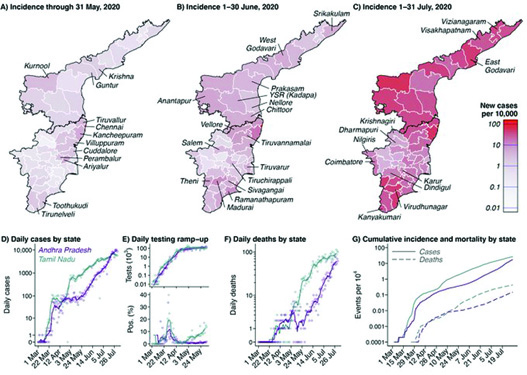NE HEALTH BUREAU
NEW DELHI, OCT 1
An epidemiological study of Coronavirus cases reported in Andhra Pradesh and Tamil Nadu till August 1 has shown that there was an enhanced risk of transmission among children of the same age group. This finding of transmission and infection risk among individuals exposed to similar-age cases was apparent among adults as well.
Largest contact tracing study to date published in @ScienceMagazine led by CDDEP finds that children are active transmitters of #COVID-19. The study also finds superspreading is common; 70% of patients do not infect any of their contacts.
Read: https://t.co/gVMM9LqBbN pic.twitter.com/jjkNfnKPi3
— CDDEP (@CDDEP) September 30, 2020
The study-‘Epidemiology and Transmission Dynamics of Covid-19 in two Indian states’, was conducted by the Center for Disease Dynamics, Economics and Policy, New Delhi, Princeton University, New Jersey, John Hopkins Bloomberg School of Public Health along with health departments of Andhra Pradesh and Tamil Nadu.
The study analyzed transmission pathways and mortality using comprehensive surveillance and contact tracing data maintained by the southern states- these are critical components of effective public health response. The states were chosen as they had a high-caseload, robust public-health system, and effective contact tracing. As of Wednesday, Tamil Nadu had 46,281 active infections and Andhra Pradesh had 59,435 active cases.
However, the analysis of transmission among children holds important clues for decision-makers as they ponder over the full reopening of schools in the coming days. The study found that the risk of enhanced transmission in similar-age pairs between contacts was strong among children aged 0-14 years and among adults aged 65 or above.
“These patterns of enhanced transmission risk in similar-age pairs…may reflect differences in the nature of intragenerational and intergenerational social and physical interactions in India,” the authors stated in their study paper, published in Science journal.
In order to understand the risks of transmission, the authors studied the secondary attack rate, which refers to the risk of transmission from an index case to an exposed contact. Assuming that contacts that tested positive were infected by the index case, the researchers estimated an overall secondary attack rate of 10.7% for high-risk contacts, who had close social contact or direct physical contact without protective measures. For low-risk contacts, the secondary attack rate stood at 4.7%.
The researchers also analyzed the transmission risks associated with different exposure settings based on data available for 18,485 contacts of 1,343 index cases. The risk of transmission for contacts was lowest, 1.2%, in healthcare settings, it was 2.6% in the community and 9% in households.
The paper further mentioned that the closure of schools and other non-pharmaceutical interventions during the study period may have contributed to a reduction in contact among children. “Nonetheless, our analyses suggest social interactions among children may be conducive to transmission in this setting,” the study stated.
Mortality and Co-Morbidity
The study also found out that the risk of death was higher among men and it increased among elderly men. Till August 1, 71 per cent of deaths in both, Tamil Nadu and Andhra Pradesh, were accounted by men. As far as the cases were concerned, till August 1, men accounted for 61% and 63% cases in TN and AP while women accounted for 39% and 37% of the cases, respectively.
It was also seen that in half of the cases ascertained before death in- Tamil Nadu and Andhra Pradesh, the deaths occurred within 6 days or lesser of testing and 1,042 fatal cases were identified 24 hours before death. If compared to the United States, the time-to-death in the two southern states was much faster than in the United States. In the US the median time-to-death from the date of admission was 13 days.
Based on comprehensive data, the study also noted that the most prevalent comorbid conditions among those who died of Covid-19 were diabetes (45%), sustained hypertension (36.2%), coronary artery disease (12.3%) and renal disease (8.2%). Diabetes was most prevalent among those who were 50-64 years at the time of death.
“At least one comorbid condition was noted among 62.5% of fatalities, in comparison to 22% of fatalities in the United States as of 30 May, 2020,” the study stated.












